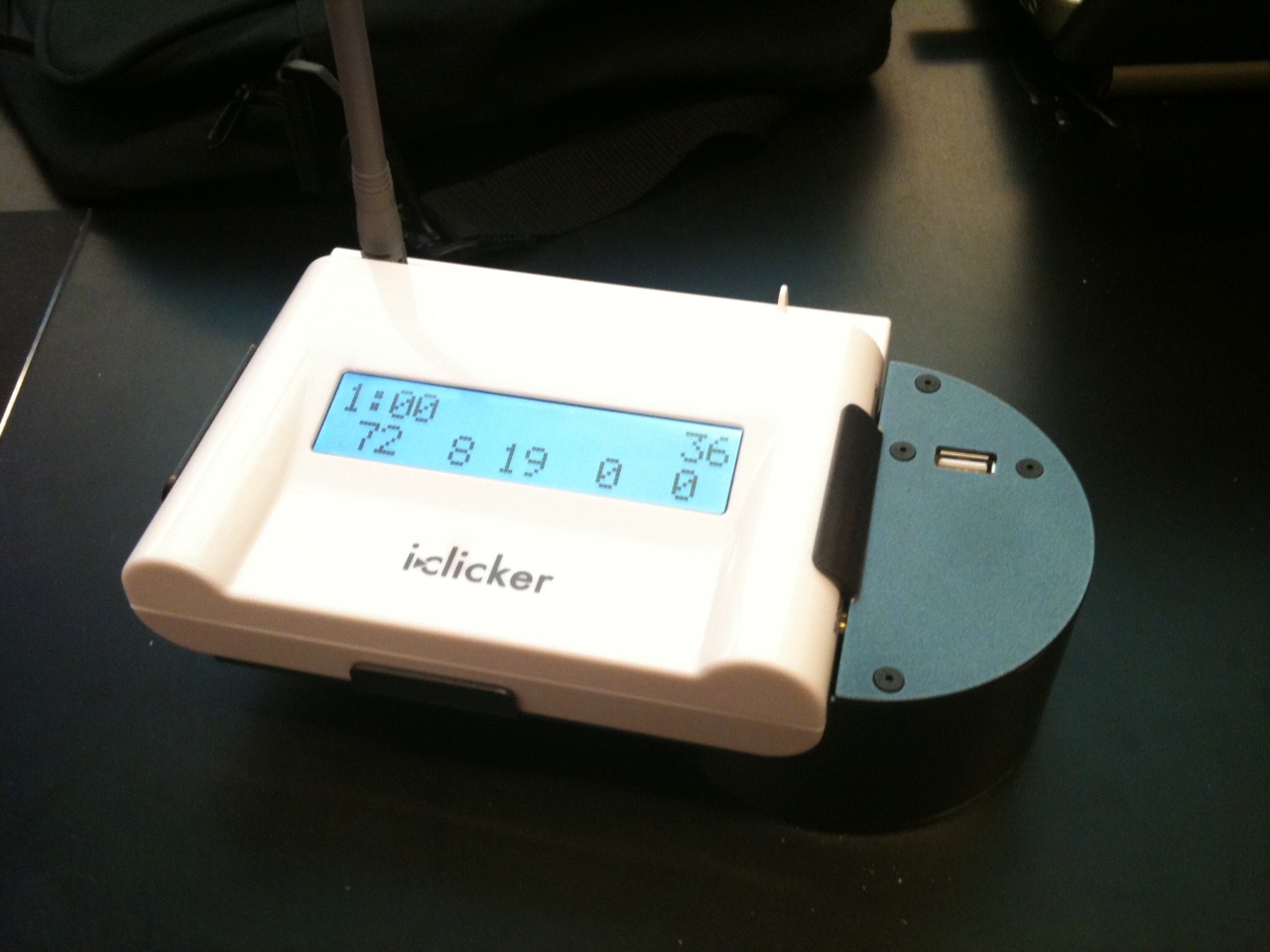As some of may have heard, i>clicker is coming out with new hardware. UBC Classroom Services is already installing the new i>clicker2 receiver in many classrooms. I’ve been working with them to design a holder that mounts the receiver on the desktop so the receiver is 1) secure 2) visible.


This new receiver is fully compatible with the current i>clicker clickers, the simple, white A-E clickers we know and love.
No surprise, along with the new receiver comes a new i>clicker2 clicker.
Hold it, hold it! Don’t have a fit! Yes, there are more buttons and that seems to explicitly contradict i>clicker’s advertised simplicity. The first time I saw it, yes, I, er, had a fit.
However, I’ve since had a long chat with my colleague Roger Freedman (follow him on Twitter @RogerFreedman ) at UCSB. He’s a great educator, textbook author, avid clicker user, and i>clicker2 guinea pig. In his opinion, which I sincerely trust, i>clicker2 opens up new and powerful avenues for peer instruction. His favourite is ranking tasks which can be implemented without those awkward clicker questions with choices like A) 1>2=3>4 B) 1=2>3=4 …
Here’s the thing(s):
- instructors could use the i>clicker2 to revert back to ineffective peer instruction questions
- i>clicker2 opens up new options for peer instruction
- they’re coming (though UBC has not declared when)
Conclusion Let’s be pro-active and prepared to train instructors when the i>clicker2 arrives.
The first step (after finishing your fit) is figuring out what the new clicker can do. And that’s the reason for this post. In 30 minutes – er, make that 11 minutes – I’ll be heading to a demo. The rest of this post will be written shortly…

It’s 3 hours later. I’m E X C I T E D! The demo with Roberto and Shannon was, well, they had a wide spectrum of audience members, from never held a clicker before to experienced users. I had a great chat with them afterwards, though. Details below, but first, some nice features of the i>clicker2 unit:

- (left) When you turn on the i>clicker2, it flashes the ID number. No more problems with the sticker getting rubbed off (though Roberto assures us they have better stickers now.)
- (center) There are only 2 batteries (but still 200 hrs of use). See those 2 little sticky-outty things at the top? They’re rubber feet to stop the clicker from sliding off the desk. Nice touch.
- (right) There’s a metal post for a lanyard. Good idea.
I won’t go into all the details about the features of the software. There are lots. You can take the tour at iclicker.com.
The hard part
Those of us who have been using i>clickers for peer instruction have gotten pretty ingenious about asking good, discussion-promoting questions even though we’re limited to choices A–E. It’s going to take some thinking and discussion to figure out how to take advantage of the expanded capabilities of the i>clicker2. Ranking tasks are a great start: students can easily enter a string of letters like BCDEA to rank items. It’s going to take some testing. Which leads to…
The great part
Roberto and Shannon are going to lend me a class set of i>clicker2’s for the term! Eighty clickers to try out in the classes I work in. Suh-weet!
I was chatting with my friend Warren (@warcode) afterwards. He said, “When you asked Roberto to show you what i>clicker2 can do that i>clicker can’t, his response was, essentially, ‘Here’s a set clickers. You tell us.’ ”
Challenge accepted! Stay tuned!





 Understanding the phases of the Moon is one of just a handful of concepts that you’ll find in every introductory, general-education “Astro 101” course. “Understanding”, of course, is a terrible description of learning. We have a much more specific learning goal:
Understanding the phases of the Moon is one of just a handful of concepts that you’ll find in every introductory, general-education “Astro 101” course. “Understanding”, of course, is a terrible description of learning. We have a much more specific learning goal: As the picture shows, we divide the Moon in half and write “NEAR” and “FAR” on the hemispheres. On the Earth ball, we draw the Equator, meridians at 0, 90, 180, 270 degrees longitude (which are 6 hours of daily rotation apart) and dashed meridians on the 45’s (3 hours of rotation apart.) A small sticker represents the observer and the cardinal points help students remember which way to spin the Earth to mimic the daily rotation.
As the picture shows, we divide the Moon in half and write “NEAR” and “FAR” on the hemispheres. On the Earth ball, we draw the Equator, meridians at 0, 90, 180, 270 degrees longitude (which are 6 hours of daily rotation apart) and dashed meridians on the 45’s (3 hours of rotation apart.) A small sticker represents the observer and the cardinal points help students remember which way to spin the Earth to mimic the daily rotation. This is a really bright lightbulb (150 W or more) on an equipment stand. To prevent light from scattering off the floor and ceiling, we built aluminum foil “baffles” that sit above and below the light. They allow only thin disk of light to shine into the room. The light bulb is set to the students’ shoulder-level so when they hold the Moon at arm’s length, the styrofoam ball naturally goes into the light.
This is a really bright lightbulb (150 W or more) on an equipment stand. To prevent light from scattering off the floor and ceiling, we built aluminum foil “baffles” that sit above and below the light. They allow only thin disk of light to shine into the room. The light bulb is set to the students’ shoulder-level so when they hold the Moon at arm’s length, the styrofoam ball naturally goes into the light. Postscript versions like
Postscript versions like 